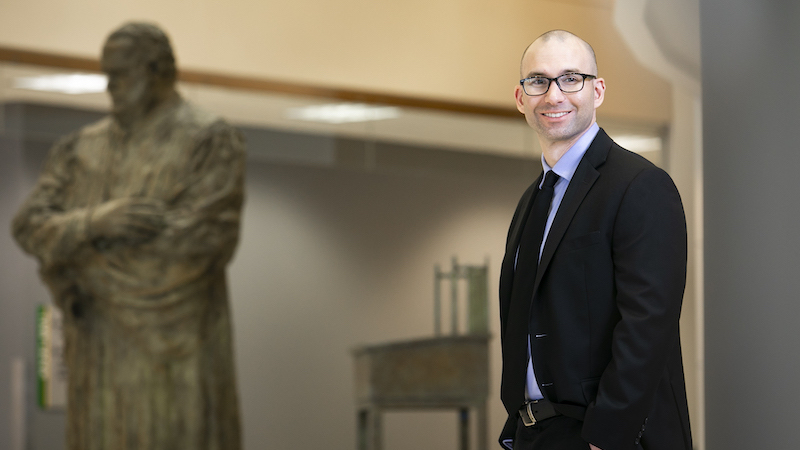Adam Crepelle had just started law school at the time of the 2010 BP Oil Spill in the Gulf of Mexico. As a citizen of the United Houma Nation, a historic Native American tribe, Crepelle felt that the consequences of the spill hit home hard.
“The Houma were getting spilled on quite heavily by BP, and everyone in Louisiana was getting BP money, except the Houma Indians,” he said. “I assumed my professors would know how to solve this problem—but I quickly realized none of my professors knew anything about Indian law, and I couldn’t find anyone who practiced Indian law in Louisiana either.”
Crepelle took it upon himself to start learning Indian law, he said, and published widely on the subject. Now the assistant professor of law at George Mason University is also the director of Mason’s new Tribal Law and Economics Program (TLEP), which includes a federal Indian Law course and the Tribal Sovereignty Clinic, where students work directly with tribes.

What is Indian Law?
“Tribes are separate sovereigns in the U.S. Constitutional order,” said Crepelle, who serves as an associate justice on the Pascua Yaqui Tribe’s Court of Appeals. “You have the federal government, state governments, and Indian Tribes.”
Because the 574 federally recognized tribes are sovereign governments, the presumption is state law does not apply on reservations, Crepelle said.
It’s a clash over who governs Indian lands, he said.
For example, according to Indian law, to arrest someone you must determine whether the victim and perpetrator are Indians, assess the type of crime, and the status of the land.
“This causes lots of public safety issues because nobody knows who can arrest who,” Crepelle said. “Law and economics study institutions and their efficiency…[the work of TLEP] is important because federal Indian law is anything but efficient.”
Working with Tribes
“Students benefit by being a part of this clinic because they get to work with tribes and implement policies that make a change in the real world,” Crepelle said. “They’re actually helping build institutions, writing laws for a sovereign nation.”
Eight students are enrolled in the clinic this semester, Crepelle said, with many working on projects related to tribal court development.
One project aims to implement the Violence Against Women Act (VAWA).
“The general rule is if a non-Indian beats his Indian wife on a reservation, the tribe can’t do anything about it,” Crepelle said. “By implementing [VAWA], now the tribe can prosecute him for domestic violence.”
“For too long [Indian nations] have been locked out, in many ways, from the opportunities and outcomes afforded to the broader U.S. population,” said Michael B. Miley, a third-year student from Vermont. “Federal Indian Law is an important and enlightening class because it precisely elucidated the myriad ways we have arrived at our current status quo.”
“Armed with this knowledge, students…are able to better meet, analyze, and resolve specific legal challenges that Indian tribes and tribal governments confront today,” Miley said.
It’s a unique opportunity for everyone involved.
“When else is a law student going to get an opportunity to write a code of civil procedure that will actually go into effect and see real cases?” said James Gray, a second-year law student who’s drafting code for an Intertribal Commercial Court about on-reservation investments and commercial disputes.
It’s more than a class assignment; it’s a responsibility.
“Mistakes could negatively impact the tribes and businesses conducting cases in the court,” said Gray, who is working with a judge from the Tunica-Biloxi tribe.
Gray said helping tribes use their sovereignty to advance their economies has been rewarding. He has also enjoyed learning from guest speakers, from tribal council members to Indian Law practitioners to former Senate advisors on Indian affairs.
“The Tribal Law and Economics Program is a really exciting opportunity for the school to grow into a field that law schools have under-invested in,” Gray said. “I think there's lots of room to make rapid progress.”
Related News
- November 19, 2023
- September 12, 2022
- March 24, 2022
- January 13, 2022
- November 5, 2020
